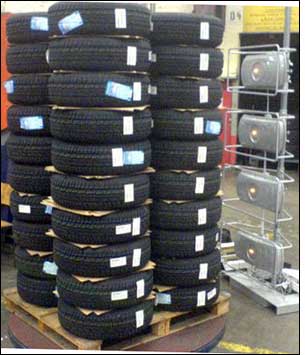International logistics provider Logwin, based in Austria, uses radio frequency identification to track the assembly and shipment of wheels for its automotive customers.
Logwin employs 8,000 people around the world, focusing its business on Austria, Germany and Switzerland. For some of its customers, such as automobile manufacturers and tire wholesalers, the firm provides assembly and warehousing services. Since one company’s steel rims are difficult to distinguish from those of another, Logwin faced the potential problem of mixing up customers’ wheels. That’s why it implemented a bar-code system to track the assembled goods in early 2007.
However, Logwin faced problems with bar codes, because with abrasion, rubber tires create a form of dust that make some bar codes unreadable. What’s more, workers often had to turn the wheels—which weigh approximately 16 kilograms (35 pounds)—to locate each bar code for scanning. Therefore, the company implemented an RFID system to track the wheels, says Michael Peschek, Logwin’s director of operations, who described his company’s efforts at the RFID Journal LIVE! Europe 2009 conference, recently held near Frankfurt, Germany.
Logwin produces about 150,000 wheels annually as part of its wheel-assembly value-added services. During this year’s fall and winter high season for tire sales, the company is relying solely on RFID for the first time. Logwin attaches EPC Gen 2 passive RFID tags to the wheels, then identifies them when they are stacked 10-high on pallets.
Much of the company’s production each year is completed between July and January, when customers put on their winter tires for the season, and many decide at that point to replace their wheels. To meet this production demand, Logwin relies on temporary manpower to do the job.
In October 2007, Logwin began implementing RFID to address the problems it had with its bar-code system, and to make the tracking system easier for seasonal workers to utilize. The firm contacted GS1 Austria about finding a solution, and was referred to auto-ID consultants BSR Idware. BSR worked to find the most suitable RFID technology for Logwin to use, as well as the optimal place on the wheel to attach the tag, and the best location to install interrogators.
Foremen check production quality as workers assemble wheels. If the wheels were assembled correctly, a Logwin employee applies an adhesive RFID label onto each tire. The wheels are then loaded on pallets and moved past a pair of towers, each fitted with two RFID interrogators that read the tires’ tags. The towers—containing two Motorola readers mounted on a tall metal frame—flank either side of an automated conveyor. If the interrogators recognize that all wheels associated with a particular batch are present, then the warehouse-management system assigns a spot for the pallet to be stored, and the conveyor belt moves the pallet of wheels to a storage area.
When a customer places an order, Logwin’s employees pick the requested wheels and pack them in stacks of 10 on pallets to be shipped out. The company uses RFID to double-check that the correct articles were picked. The pallet is then moved to a stretch-wrap machine, where another pair of towers—each fitted with four Motorola interrogators—reads the wheels’ RFID labels. As pallets are turned and tires are covered with plastic, the readers confirm that the wheels were picked correctly. If the picked products do not match the customer’s order, the packing machine shuts down.
The advantages of the system, Peschek says, are its robustness for the industrial environment, the fact that rubber dust does not keep RFID tags from being read, and the time and labor saved, since workers no longer have to turn heavy wheels looking for bar-coded labels. The system also ensures that customers’ products are not mixed up, and requires little or no training for use by seasonal workers.
Logwin produces roughly 160,000 to 170,000 RFID labels each year, using an RFID printer-encoder manufactured by Zebra Technologies.
“As a service provider, we decided to implement such a solution even though the requirement was not coming from the industry, or from our customers,” Peschek says. “I think this is what gives courage to other service providers to start using RFID.” The technology, he explains, “improves a simple process and generates value by reducing handling work and expanding capacity.”



